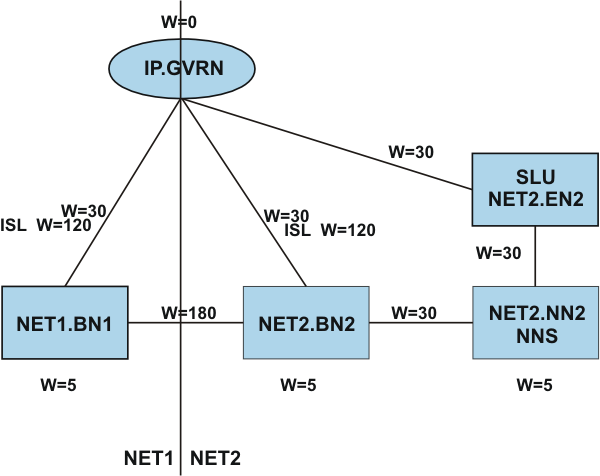 z/OS Communications Server: SNA Network Implementation Guide
z/OS Communications Server: SNA Network Implementation Guide
 z/OS Communications Server: SNA Network Implementation Guide
z/OS Communications Server: SNA Network Implementation Guide
|
Previous topic |
Next topic |
Contents |
Contact z/OS |
Library |
PDF
Cross-subnet routing with global VRNs z/OS Communications Server: SNA Network Implementation Guide SC27-3672-01 |
|
|
With border node architecture, topology information about nodes, TGs, and their characteristics that determine weights, is not passed across subnet boundaries by way of topology database update (TDU) flows. When a session path is determined to cross subnet boundaries, the optimal route (lowest weight) is calculated in each subnet. The complete end-to-end route consists of contiguous route segments which are individually optimal within their native subnet, but not necessarily optimal from end to end. Global virtual routing nodes (GVRNs) can be used to provide a more direct route between two endpoints in different subnets. Figure 1 shows a border node configuration with a GVRN. The weights in the figure are those displayed with DISPLAY NET,TOPO,ID=cpname,APPNCOS=cos or DISPLAY NET,TOPO,ORIG=orig,DEST=dest,APPNCOS=cos commands. Figure 1. Global VRN with extended border nodes
 A TG that originates in a border node and that has a GVRN as the destination can be used across a subnet boundary or used within a single subnet. (An intersubnet link (ISL) between two border nodes cannot be used in this way.) If the TG is used to calculate the session route and the PLU node that calculates the route is in another subnet, then the TG is being used as an intersubnet link (ISL). When the same TG is used within a single subnet, the TG is not considered to be an ISL. In many ways, the border node in one subnet is treated
the same way that an end node is, in that it is considered to be the
endpoint of the route calculated in another subnet. For example,
in the configuration shown in Figure 1,
assume that the PLU is on NET1.BN1 and the SLU is on NET2.EN2. The
only information passed to NET1.BN1 on a LOCATE would be:
The ISL between the two border nodes and the ISL TG to IP.GVRN would contain the encapsulated best route from NET2.BN2 to NET2.EN2, but the LOCATE would only include the TG characteristics (in a control vector x'47') for the ISL TGs themselves. Because the weights are determined by the TG characteristics in the x'47' control vectors, NET1.BN1 considers the two TGs to IP.GVRN to have equal weights of 30. Because the two weights are equal, and the weight of the ISL between the two border nodes has a higher weight of 180, one of the two lower weight routes is randomly selected. For additional information about weight computation see Example of weight computation and Forcing an APPN route in a VTAM network. Because you would normally want your session path to be the two hop route of NET1.BN1->IP.GVRN->NET2.EN2, there is a way to prefer this route over one that transverses an ISL, which might contain additional encapsulated session hops. z/OS® Communications Server uses the COSTBYTE TG characteristic to prefer the more direct route. When a TG from a border node to a GVRN is being used as an ISL, the COSTBYTE value of 0 is temporarily changed to 1 (in the x'47' control vector when the TG control vectors are sent to another subnet in a LOCATE) to increase the weight of the TG. If the existing COSTBYTE value assigned to the TG is not 0, no change is made, and the weight will be the same whether the TG is used as an ISL. The weights used in route calculation are displayed in
the output of DISPLAY NET,TOPO,ORIG=orig,DEST=dest,APPNCOS=cos:
Unlike the ISL to a GVRN, where the COSTBYTE can be temporarily set to 1 when the TG is sent to another subnet in a LOCATE, the COSTBYTE of an ISL between two border nodes is defaulted to 1 when the ISL is activated. The COSTBYTE for this ISL can be changed from the default by specifying a COSTBYTE value on the PU definition for the ISL connection. This can lower the weight of the ISL, causing sessions to be routed through the direct ISL instead of taking the more optimal route through the GVRN. When you display TG information for an ISL between two
border nodes with the DISPLAY NET,TOPO,ORIG=orig,DEST=dest,APPNCOS=cos
command, the weight that is displayed in messages IST1300I and IST1301I
is the weight of the ISL when it is used cross-subnet:
Guideline: To favor the two
hop GVRN route between cross-subnet session partners, you can override
the COSTBYTE in a TGP assigned to a direct ISL between two border
nodes. This will cause it to have a higher weight than the total
weight of a route through a GVRN between the two subnets, considering
the ISL weight of a TG between a border node and a GVRN.
TG characteristics (COSTBYTE, COSTTIME, CAPACITY, etc.) can be assigned to a TG either individually or with a TG Profile (TGP), which contains a set of TG characteristics. The TG characteristics of the TGP assigned to an ISL are specified on the PU statement of the PU that is activated to start the ISL TG. The TG characteristics or the TGP assigned to a TG associated with a GVRN are specified on the PORT or GROUP statement that defines that GVRN in the Enterprise Extender (MEDIUM=HPRIP) XCA major node. See z/OS Communications Server: SNA Resource Definition Reference for additional information. 


|
 Copyright IBM Corporation 1990, 2014 Copyright IBM Corporation 1990, 2014 |